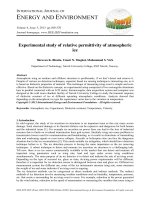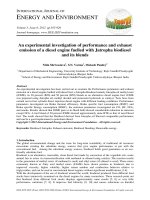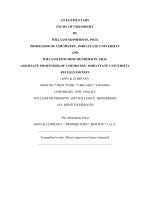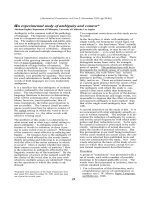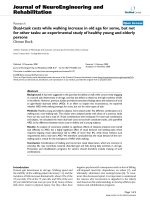An experimental study of temperatures in cloud from release of flashing liquid CO2 in 3m long channel
Bạn đang xem bản rút gọn của tài liệu. Xem và tải ngay bản đầy đủ của tài liệu tại đây (697.08 KB, 8 trang )
INTERNATIONAL JOURNAL OF
ENERGY AND ENVIRONMENT
Volume 5, Issue 5, 2014 pp.567-574
Journal homepage: www.IJEE.IEEFoundation.org
ISSN 2076-2895 (Print), ISSN 2076-2909 (Online) ©2014 International Energy & Environment Foundation. All rights reserved.
An experimental study of temperatures in cloud from
release of flashing liquid CO
2
in 3m long channel
Amrit Adhikari, André V. Gaathaug, Dag Bjerketvedt, Knut Vaagsaether
Telemark University College, Porsgrunn, Norway.
Abstract
Flashing of the liquid CO
2
is an accidental hazards that may occurs in many industrial sector such as,
process industries, carbon capture and storage projects, crude oil extraction process etc. Sometimes the
accidental release of liquid CO
2
that causes the health hazards which may costs loss of lives and
properties. In order to alleviate the aforementioned probable hazards, the experiment will be highly
beneficial. This research activity is conducted through the temperature measurement in the cloud of
flashing liquid CO
2
confirming the formation of dry ice and measuring frontal velocity of the cloud as
well as its height formed from the vapour CO
2
dispersion. The liquid CO
2
was released in the 3m long
channel from the cylinder through two nozzles of diameter 0.5mm and 1.0mm. This leads the formation
of dry ice measuring -73
o
C and -71
o
C from the nozzle sized 0.5mm and 1.0mm respectively. 0.5mm
nozzle and 1.0mm nozzle having mass flow rate of liquid CO
2
as 0.0089 kg/s and 0.029 kg/s, overall
frontal velocity of 0.52 m/s and 1.51 m/s thus formed cloud height measuring 0.05m and 0.1m
respectively. Frontal velocity of the cloud was found to be highest at distance of 0.5m from nozzle with
1.49 m/s and 5.5 m/s for both nozzles 0.5mm and 1.0mm diameter respectively. Upon the increasing
distance from the nozzle, the temperature of the formed cloud was seen to be in increasing order.
Copyright © 2014 International Energy and Environment Foundation - All rights reserved.
Keywords: CCS; Carbon dioxide; Dispersion; Flashing liquid; Temperature measurement.
1. Introduction
Accidental release of the pressurized liquid gases has caused numerous accidents all over the world. The
release of pressurized gas generates flammable and toxic gases clouds. The hazard of CO
2
is a natural
events, in Cameroon, West Africa, sudden release of Carbon Dioxide(CO
2
) gas from Lake Nyos caused
the deaths of around 1700 people on 21 August 1986 [1].
Carbon Capture and Storage(CCS) are known as globally mitigating technology as it can capture and
store large amount of CO
2
and preventing it to reach the atmosphere. In CCS projects, large quantity of
CO
2
is compressed to high pressure that can be transported to the storage site. Accidental release of
pressurized CO
2
while transporting and storing cause flashing of liquid and a huge amount of gas is
escaped which can cause frostbite and asphyxiation [2].
With the increase of the respiration problem, if CO
2
concentration is above 5% approximately it causes
other health symptoms, such as headache, palpitation, breathing difficulty, weakness and dizziness. 20%
of CO
2
gas is considered to be instantaneously fatal for the human health [3].
Lisbona et al. [4] wrote, “Currently, the source term for a CO
2
release is not well understood because of
its complex thermodynamic properties and its tendency to form solid particles under specific pressure
International Journal of Energy and Environment (IJEE), Volume 5, Issue 5, 2014, pp.567-574
ISSN 2076-2895 (Print), ISSN 2076-2909 (Online) ©2014 International Energy & Environment Foundation. All rights reserved.
568
and temperature conditions. This is a key knowledge gap and any subsequent dispersion modelling,
particularly when including topography, may be affected by the accuracy of the source term”. It is very
important to know and predict the behavior of flashing liquid so that an accidental release could be
prevented and mitigated. The temperature measurement gives knowledge of understanding two phase
dense gas dispersion. This paper presents the result from the experiments to investigate flashing
scenarios of liquid CO
2
. The major goal of this paper is to ensure and include:
• Released liquid CO
2
includes phase transition into mixture of gas and solid with formation of dry ice.
• Froude Scaling can be used to validate high pressure CO
2
dispersion.
CO
2
is a heavy-gas and under normal pressure and temperature it is a colorless and odorless gas. It is
denser than air because of different specific weight of the air and CO
2
which leads to form a gravity
current flow [5]. When liquid CO
2
is emptying from a horizontal channel with constant cross-section, it
changes its phase to dry ice and vapour [6]. The dry ice is formed and deposited in the horizontal channel
base and the vapour mixes with air to form cloud and moves forward with frontal velocity, u. The mass
of the heavy gas cloud increased due to air entrainment. Figure 1 describes the flow design of the liquid
CO
2
flowing in a horizontal channel with constant cross section area.
Figure 1. Flow model for liquid CO
2
released in the rectangular channel
The mass balance of the model from Figure 1 can be described as below:
airvapourdryiceairliquid
mmmmm
+
+
=+ (1)
where
m
liquid
is mass flow rate of liquid CO
2
(kg/s), m
dry ice
is mass flow rate of solid CO
2
(kg/s) and
m
air
is mass flow rate of air (kg/s).
2. Experiment setup
The experiment setup is shown in Figure 2 and Figure 3. The experiment was conducted on long channel
tube comprising of 3m length, 0.1m width and 0.1m height. The system was made up of transparent
polycarbonate and steel. The designing of tube was closed on one end and open at the other. The system
comprised of five type K thermocouple with different time responding units. The thermocouple T#1 was
placed at the side glass wall at height of 0.05m, thermocouple T#2 at distance 0.5m, thermocouple T#3
and T#4 at 1.5m, and thermocouple T#5 at 2.5m from the side wall of the tube. T#1 and T#4 has
response time of 0.08 s, T#3 and T#5 with a respond time 1 µs and T#2 is slow responding
thermocouple. The layout of the experimental setup of the channel has been shown in Figure 2.
Liquid CO
2
is released from the top of the channel with the nozzle of 0.5mm and 1.0mm diameter. The
nozzle is placed 0.1m from the closed end of the channel.
The experimental setup for measuring temperature in the cloud from flashing of liquid CO
2
is illustrated
in Figure 3.
The liquid CO
2
gas cylinder is connected to the pneumatic valve which is further connected to the nozzle.
The liquid CO
2
was supplied from the cylinder. The mass flow of liquid CO
2
released was measured by
standard ‘HBM RSCA 100 kg’ load cell device, and the cylinder was suspended in the load cell device.
The initial and final weight of the cylinder during the release of liquid CO
2
with respect to time was
noted down, which in fact, helps to calculate the mass flow rate of liquid CO
2
from the cylinder.
Signal from the thermocouples and load cell were connected to the ‘QuantumX MX410’ amplifier via
which data were logged. Sampling rate of data was used as 2400 Hz.
ṁ
liquid
ṁ
air
ṁ
dryice
ṁ
vapour+
ṁ
air
F
u
International Journal of Energy and Environment (IJEE), Volume 5, Issue 5, 2014, pp.567-574
ISSN 2076-2895 (Print), ISSN 2076-2909 (Online) ©2014 International Energy & Environment Foundation. All rights reserved.
569
Figure 2. Schematic setup showing temperature measurement location and liquid CO
2
inlet
Figure 3. Experimental setup for the liquid CO
2
release system
3. Results and discussion
3.1 Frontal velocity and cloud height
Frontal velocity in this experiment is the velocity of CO
2
-air cloud which is defined as, u
F
(m/s) and
which was found from HD video recording. As liquid CO
2
was released from the 0.5mm nozzle
diameter, the overall frontal velocity of the cloud was found to be 0.52 m/s as shown in Figure 4.
Flow from the 1.0mm diameter nozzle gives the overall frontal velocity of 1.51 m/s which is shown in
Figure 5.
Figure 4. Photo of carbon dioxide propagation with the 0.5 mm nozzle
International Journal of Energy and Environment (IJEE), Volume 5, Issue 5, 2014, pp.567-574
ISSN 2076-2895 (Print), ISSN 2076-2909 (Online) ©2014 International Energy & Environment Foundation. All rights reserved.
570
Figure 5. Photo of carbon dioxide propagation with the 1.0 mm nozzle
The experimental results has shown two different regimes of the flow of vapour CO
2
inside the channel.
The flow regimes are shown in Figures 4 and 5. Gravity current flow was observed from the release of
0.5mm nozzle, whereas plug flow was observed when release from 1.0mm nozzle diameter.
The time taken for CO
2
cloud to reach the various distance in the channel is shown in Figure 6 which
gives the information about the initial and later frontal velocity of the cloud. Frontal velocity of the cloud
was found to be increased rapidly until the cloud distance of 0.5m as shown in Figure 6.
Figure 6. Distance variation with time and frontal velocity, symbols refers to nozzle diameter:
♦ 1.0mm nozzle; ■ 0.5mm nozzle
At distance 0.5m form the nozzle, the frontal velocity of cloud when released from 0.5mm and 1.0mm
nozzle diameter were found to be 1.49 m/s and 5.5 m/s respectively. Later after 1m of release distance,
frontal velocity were approximately constant.
Using the video, the height of the cloud was estimated. As it can be noticed from Figure 5, there is a plug
flow in the channel after liquid CO
2
is released from 1.0mm nozzle diameter. The height of the cloud is
same as the height of the channel i.e. 0.1m .
Height of the cloud after it is release from 0.5mm nozzle diameter was found to be half of the height of
the channel. From the video, it can be concluded that, the height of the cloud was approximately 0.05m
as shown in Figure 4.
Nozzle diameter affects the height and frontal velocity of the cloud. Higher the nozzle diameter for the
release of liquid CO
2
in the atmosphere, higher will be the cloud height as well as frontal velocity of the
cloud.
3.2 Froude scaling
With knowledge of the frontal velocity, Froude scaling with this type of experiments can be performed.
Froude number is defined as the ratio between the momentum and gravity force acting in the fluid flow
which is given as:
gh
u
Fr =
(2)
0
1
2
3
4
5
6
00.511.522.53
Arrivaltime(s)
Clouddistancefromnozzle(m)
0
1
2
3
4
5
6
00.511.522.53
Frontalvelocity(m/s)
Clouddistancefromnozzle(m)
International Journal of Energy and Environment (IJEE), Volume 5, Issue 5, 2014, pp.567-574
ISSN 2076-2895 (Print), ISSN 2076-2909 (Online) ©2014 International Energy & Environment Foundation. All rights reserved.
571
where u is a velocity (m/s), g is the acceleration of gravity (m/s
2
), h is height of cloud (m).
Experiment from 0.5mm nozzle shows frontal velocity of 0.52 m/s with Froude number of 0.74. Based
on the observed Froude number, it suggests to be in a range of Froude scaling which was done in same
type of experiment but with hydrogen-air [7]. Gravity current effect was observed from the release of
0.5mm diameter nozzle as seen in Figure 4 and with smaller nozzle than 0.5mm gravity current effects
can be studied and used for the Froude scaling.
3.3 Mass flow of liquid CO
2
The mass flow of liquid CO
2
in 1.0mm and 0.5mm diameter nozzles were 0.029 kg/s and 0.0089 kg/s
respectively as shown in Figure 7 verifying that the mass flow of liquid CO
2
is dependent on nozzle
diameter. Wider the diameter of the nozzle, higher will be the mass flow of liquid CO
2
.
(a) (b)
Figure 7. Mass flow of liquid CO
2
from (a) 0.5mm nozzle, (b) 1.0mm nozzle
3.4 Temperature measurements
In this experiment, the temperature of the cloud after flashing of liquid CO
2
was considered . The
temperature reading of CO
2
(solid and vapour) when released from 0.5mm diameter nozzle as shown in
Figure 8 below. Initially, all the thermocouple were at room temperature. With the release of liquid CO
2
,
the significant reduction in temperature was noticed. Whereas, air temperature by T#3 into the channel,
remained almost constant throughout the flow.
0 10 20 30 40 50 60 70 80
‐80
‐60
‐40
‐20
0
20
40
Time(s)
Temperature(°C)
T#1
T#3
T#4
T#5
Figure 8. Temperature of CO
2
(solid and vapour) when released from 0.5mm diameter nozzle
T#1 suggests the formation of the dry ice whose temperature is about -73
o
C at 1 bar which is almost
accurate as we find in literatures that a dry ice temperature at 1 bar is -78.4°C or 194.75 K [8].
Released of liquid CO
2
in the atmosphere from cylinder of high pressure changes its phase to solid and
vapour. The temperature of the CO
2
cloud and dry ice is constant after it get stabilized at specific point
10 20 30 40 50 60 70
66.2
66.4
66.6
66.8
67
67.2
Time(s)
Mass(kg)
y=‐0.0089*x+67
LiquidCO
2
10 20 30 40 50
65
65.5
66
66.5
Time(s)
Mass(kg)
y=‐0.029*x+66
LiquidCO
2
International Journal of Energy and Environment (IJEE), Volume 5, Issue 5, 2014, pp.567-574
ISSN 2076-2895 (Print), ISSN 2076-2909 (Online) ©2014 International Energy & Environment Foundation. All rights reserved.
572
over time as shown by thermocouple T#1, T#3 and T#5 from both Figure 8 and Figure 9. The
temperature reading of CO
2
(solid and vapour), when released from 1.0mm diameter nozzle, is shown in
Figure 9.
Figure 9. Temperature of CO
2
(solid and vapour) when released from 1.0 mm diameter nozzle
The air temperature(T#4) is not constant which is due to heat transfer from cloud CO
2
to air, and it is a
plug flow as shown in Figure 5. Dry ice is formed in T#1 and T#2 which are at minimum temperature of
-71
o
C and -63.5
o
C. Slow thermocouple T#2 takes relatively long time to reach the stabilized temperature
and its graph is not shown in both Figure 8 and Figure 9. The image of the formation of dry ice on the tip
of thermocouple T#1 and T#2 and on channel base can be seen in the Figure 10. Dry ice stays in the
channel for the long time and vaporize into gas in atmospheric pressure.
Figure 10. Picture of formation of dry ice
Temperature of CO
2
cloud increases with increasing distance of release from the nozzle. The reason
behind this is due to the heat transfer into the system from the surrounding. Figure 11 shows that there is
a continuous increase in temperature of the cloud as cloud hits the thermocouples down the channel. The
stabilized temperature data were used to find out the relation between the opening area of release and
temperature at various distance.
However, from both nozzles we can find the difference in the temperature at different distance. When the
nozzle diameter is increased to twice(from 0.5mm to 1.0mm) then there is a decrement of CO
2
cloud
temperature by approximately -32
o
C and -37
o
C at T#3 and T#5 distance respectively.
0 10 20 30 40 50 60 70 80
‐80
‐60
‐40
‐20
0
20
Time(s)
Temperature(°C)
T#1
T#3
T#4
T#5
International Journal of Energy and Environment (IJEE), Volume 5, Issue 5, 2014, pp.567-574
ISSN 2076-2895 (Print), ISSN 2076-2909 (Online) ©2014 International Energy & Environment Foundation. All rights reserved.
573
‐80
‐60
‐40
‐20
0
20
40
‐0.5 0 0.5 1 1.5 2 2.5 3
Temperature(°C)
Clouddistancefromnozzle(m)
Inside
cylinder
Figure 11.Stablized temperature of CO
2
cloud at different distance, symbols refers to nozzle diameter:
♦ , 1.0mm nozzle; ■ , 0.5mm nozzle
4. Conclusion
The temperature measurement of cloud of the flashing liquid CO
2
was investigated by conducting
experiments in a 3m long square cross section channel. The liquid CO
2
was released from two different
nozzles of diameter 0.5mm and 1.0mm. Release of liquid CO
2
form 0.5mm and 1.0mm nozzle diameter
gives the constant frontal velocity of 0.52 m/s and 1.51 m/s respectively over 3m long channel. Sudden
release from the nozzle has higher frontal velocity of 1.49 m/s and 5.5 m/s for both nozzles of 0.5mm
and 1.0mm diameter respectively. The cloud was found to be 0.05m and 0.1m when liquid CO
2
was
released from 0.5mm and 1.0mm diameter nozzle respectively. The mass flow of liquid CO
2
in 0.5mm
and 1.0mm diameter nozzle was found to be 0.0089 kg/s and 0.029 kg/s respectively. Using of small
diameter nozzles to perform Froude scaling was suggested. The nozzle diameter suggests that wider the
nozzle diameter higher will be the frontal velocity, cloud height and mass flow rate of liquid CO
2
.
Dry ice and vapour CO
2
was formed from flashing of pressurized CO
2
. Dry ice stays for the long time
that influence the dispersion. Temperature of cloud was found to be in increasing with increase of the
distance from the nozzle. The temperature of the cloud and dry ice is found to be constant at specific
point and over time which also helped understanding the behavior of slow and fast responding
thermocouple.
Further work is to study the heat transfer into the system. The heat transfer is important parameter in
determining the temperatures and how it affects to vapourize dry ice into CO
2
gas. Further work will help
to develop Froude scaling and models that can predict the concentration and dispersion phenomena of
accidental release of liquid CO
2
.
Acknowledgements
The authors acknowledge the support from the Statoil ASA.
References
[1] Kling, G.W., et al., The 1986 Lake Nyos Gas Disaster in Cameroon, West Africa. Science, 1987.
236(4798): p. 169-175.
[2] Scott, J.L., D.G. Kraemer, and R.J. Keller, Occupational hazards of carbon dioxide exposure.
Journal of Chemical Health and Safety, 2009. 16(2): p. 18-22.
[3] Kruse, H. and M. Tekiela, Calculating the consequences of a CO2-pipeline rupture. Energy
Conversion and Management, 1996. 37(6-8): p. 1013-1018.
[4] Lisbona, D., et al., Risk assessment methodology for high-pressure CO2 pipelines incorporating
topography. Process Safety and Environmental Protection, 2014. 92(1): p. 27-35.
[5] Simpson, J.E., Gravity Currents: In the Environment and the Laboratory. 2 ed. 1997, Cambridge
University Press.
[6] Molag, M. and C. Dam, Modelling of accidental releases from a high pressure CO2 pipelines.
Energy Procedia, 2011. 4(0): p. 2301-2307.
International Journal of Energy and Environment (IJEE), Volume 5, Issue 5, 2014, pp.567-574
ISSN 2076-2895 (Print), ISSN 2076-2909 (Online) ©2014 International Energy & Environment Foundation. All rights reserved.
574
[7] Sommersel, O.K., et al., Experiments with release and ignition of hydrogen gas in a 3 m long
channel. International Journal of Hydrogen Energy, 2009. 34(14): p. 5869-5874.
[8] Witlox, H.W.M., M. Harper, and A. Oke, Modelling of discharge and atmospheric dispersion for
carbon dioxide releases. Journal of Loss Prevention in the Process Industries, 2009. 22(6): p. 795-
802.
Amrit Adhikari has graduated in Bachelor of Technology in Environmental Engineering from the
Kathmandu University, Nepal. He is currently student of Master in Process Technology at Telemar
k
University College, Norway. His research interests cover the areas of renewable energy, energy
efficiency, technical safety, CO
2
safety, environmental pollution, oil processing systems and transport
technology. He has presented and published two papers in the international conferences.
E-mail address:
André V. Gaathaug obtained his master’s degree in Process Technology and his PhD degree in
Deflagration to Detonation Transition in Hydrogen-Air from Telemark University College, Norway. He
is currently working as Assistance Professor at Telemark University College. Dr. Gaathaug is teaching
b
achelor level with subjects Physics, Thermodynamics and Technical safety. His main area of expertise
is hydrogen safety, CO
2
safety, explosion, gas dynamics and thesis supervisor of master students. He
has published 4 journal paper and 4 conference paper. He is also fellow of IEA-HIA Task 31.
E-mail address:
Dag Bjerketvedt is professor in energy and combustion technology at Telemark University College. He
obtained his doctor degree from NTH (NTNU) in 1985. He has worked in the process and off-shore
industry. His research interests include gas explosions, detonations, process safety, BLEVE, shoc
k
waves and accident investigations. He is the author of the CMR-GexCon Gas Explosion Handbook.
E-mail address:
Knut Vaagsaether completed his PhD degree in Modelling of Gas Explosion from Telemar
k
University College, Norway in 2010. Dr. Vaagsaether is currently Associate Professor at Dept. o
f
Process, Energy and Environmental Technologies in Telemark University College. His present research
interest includes gas explosion, gas dynamics and fast phase transition. He has published ten journal
p
apers and 13 conference papers. He is also working part time as a Project Engineer at VEAS (surge
treatment).
E-mail address:
